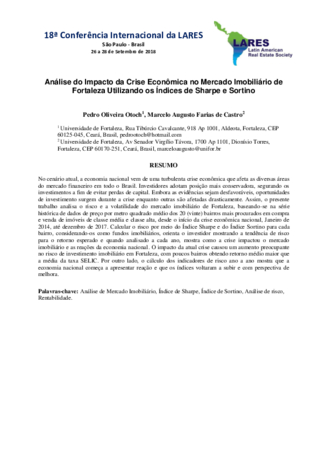No cenário atual, a economia nacional vem de uma turbulenta crise econômica que afeta as diversas áreas do mercado financeiro em todo o Brasil. Investidores adotam posição mais conservadora, segurando os investimentos a fim de evitar perdas de capital. Embora as evidências sejam desfavoráveis, oportunidades de investimento surgem durante a crise enquanto outras são afetadas drasticamente. Assim, o presente trabalho analisa o risco e a volatilidade do mercado imobiliário de Fortaleza, baseando-se na série histórica de dados de preço por metro quadrado médio dos 20 (vinte) bairros mais procurados em compra e venda de imóveis de classe média e classe alta, desde o início da crise econômica nacional, Janeiro de 2014, até dezembro de 2017. Calcular o risco por meio do Índice Sharpe e do Índice Sortino para cada bairro, considerando-os como fundos imobiliários, orienta o investidor mostrando a tendência de risco para o retorno esperado e quando analisado a cada ano, mostra como a crise impactou o mercado imobiliário e as reações da economia nacional. O impacto da atual crise causou um aumento preocupante no risco de investimento imobiliário em Fortaleza, com poucos bairros obtendo retorno médio maior que a média da taxa SELIC. Por outro lado, o cálculo dos indicadores de risco ano a ano mostra que a economia nacional começa a apresentar reação e que os índices voltaram a subir e com perspectiva de melhora.
In the current scenario, the national economy comes from a turbulent economic crisis that affects the various areas of the financial market throughout Brazil. Investors adopt a more conservative position, holding the investments to avoid capital losses. While the evidence is unfavorable, investment opportunities emerge during the crisis while others are drastically affected. Thus, the present study analyzes the risk and volatility of the Fortaleza real estate market, based on the historical data series of average square meters of the 20 (twenty) most sought-after neighborhoods in the purchase and sale of middle-class and class properties high, since the beginning of the national economic crisis, from January 2014 until December 2017. Calculating the risk through the Sharpe Index and the Sortino Index for each neighborhood, considering them as real estate funds, guides the investor by showing the risk trend for the expected return and when analyzed each year, shows how the crisis impacted the real estate market and the reactions of the national economy. The impact of the current crisis caused a worrisome increase in the risk of real estate investment in Fortaleza, with few neighborhoods obtaining an average return higher than the average SELIC rate. On the other hand, the calculation of year-on-year risk indicators shows that the national economy begins to react and that the indexes have risen again.
